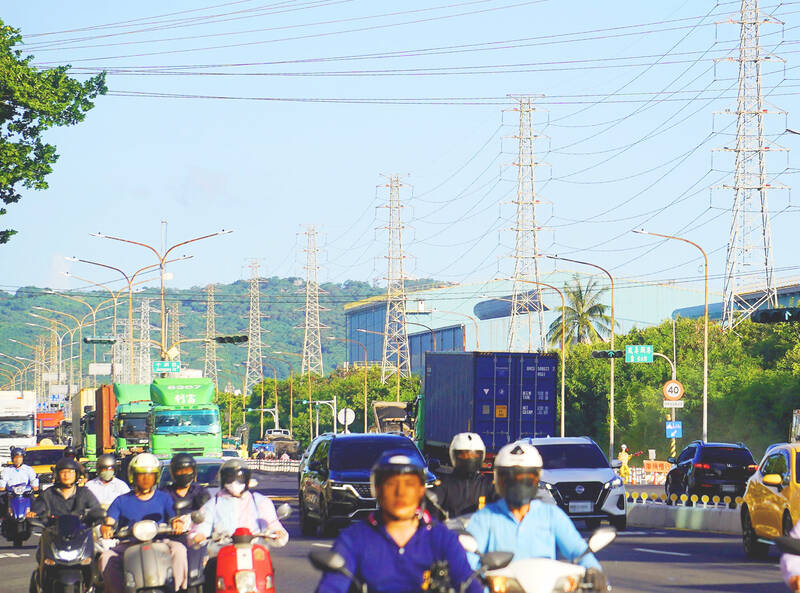Electricity consumption in Taiwan hit a record high of 41.18 gigawatts (GW) yesterday as scorching hot weather continued across the country, state-run Taiwan Power Co (Taipower) said.
The instantaneous peak load was recorded at 1:52pm, surpassing the previous record of 40.74GW set on July 22, 2022, and is close to Taipower’s estimated peak of 41.19GW for this year.
Taipower attributed the record high power demand to the muggy condition caused by the high humidity before rainfall, which boosted residential use of air-conditioning.

Photo: CNA
Temperatures yesterday in Yunlin County’s Dounan Township (斗南) hit 38.4 degrees Celsius, while temperatures higher than 37 degrees were recorded in other parts of central and southern Taiwan as well as Taipei’s Shezidao (社子島) area.
Meanwhile, the Central Weather Administration (CWA) issued an “orange” alert for Taipei, New Taipei City and Taichung, as well as some parts of central and southern Taiwan, meaning daytime highs in these areas could reach 36 degrees for three consecutive days.
Yesteday’s maximum power supply capability was 47.33GW, with an operating reserve of 16.86 percent, giving a green light that symbolizes “adequate power supply,” according to Taipower’s official Web site.
Taipower data showed the third-highest power consumption level was 40.66GW set on July 25, 2022, followed by 40.63GW and 40.57GW on June 21 and June 28 this year, respectively.
With more sources of solar power to be connected to the grid, Taipower said it expects operating reserves this month to remain at a healthy level of more than 10 percent during the day and 7 percent at night, within the “yellow” power supply range of 6-10 percent.
A yellow alert light means that the electricity supply is under constraint, the company said.

CHIP RACE: Three years of overbroad export controls drove foreign competitors to pursue their own AI chips, and ‘cost US taxpayers billions of dollars,’ Nvidia said China has figured out the US strategy for allowing it to buy Nvidia Corp’s H200s and is rejecting the artificial intelligence (AI) chip in favor of domestically developed semiconductors, White House AI adviser David Sacks said, citing news reports. US President Donald Trump on Monday said that he would allow shipments of Nvidia’s H200 chips to China, part of an administration effort backed by Sacks to challenge Chinese tech champions such as Huawei Technologies Co (華為) by bringing US competition to their home market. On Friday, Sacks signaled that he was uncertain about whether that approach would work. “They’re rejecting our chips,” Sacks

Taiwan’s exports soared 56 percent year-on-year to an all-time high of US$64.05 billion last month, propelled by surging global demand for artificial intelligence (AI), high-performance computing and cloud service infrastructure, the Ministry of Finance said yesterday. Department of Statistics Director-General Beatrice Tsai (蔡美娜) called the figure an unexpected upside surprise, citing a wave of technology orders from overseas customers alongside the usual year-end shopping season for technology products. Growth is likely to remain strong this month, she said, projecting a 40 percent to 45 percent expansion on an annual basis. The outperformance could prompt the Directorate-General of Budget, Accounting and

NATIONAL SECURITY: Intel’s testing of ACM tools despite US government control ‘highlights egregious gaps in US technology protection policies,’ a former official said Chipmaker Intel Corp has tested chipmaking tools this year from a toolmaker with deep roots in China and two overseas units that were targeted by US sanctions, according to two sources with direct knowledge of the matter. Intel, which fended off calls for its CEO’s resignation from US President Donald Trump in August over his alleged ties to China, got the tools from ACM Research Inc, a Fremont, California-based producer of chipmaking equipment. Two of ACM’s units, based in Shanghai and South Korea, were among a number of firms barred last year from receiving US technology over claims they have

BARRIERS: Gudeng’s chairman said it was unlikely that the US could replicate Taiwan’s science parks in Arizona, given its strict immigration policies and cultural differences Gudeng Precision Industrial Co (家登), which supplies wafer pods to the world’s major semiconductor firms, yesterday said it is in no rush to set up production in the US due to high costs. The company supplies its customers through a warehouse in Arizona jointly operated by TSS Holdings Ltd (德鑫控股), a joint holding of Gudeng and 17 Taiwanese firms in the semiconductor supply chain, including specialty plastic compounds producer Nytex Composites Co (耐特) and automated material handling system supplier Symtek Automation Asia Co (迅得). While the company has long been exploring the feasibility of setting up production in the US to address